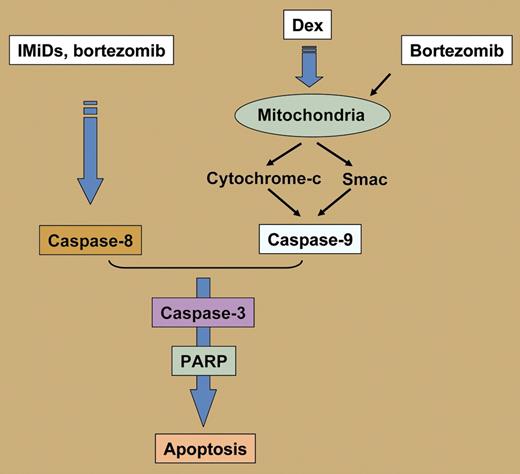The use of novel agents both singularly and in combination has transformed the treatment paradigm for patients with multiple myeloma. Now, the combination of bortezomib and thalidomide with the more traditional doublet of melphalan and prednisone has delivered a remarkably high response rate and favorable toxicity profile in patients with relapsed multiple myeloma.
Within the last 8 years, novel, biologically derived treatment options have changed the management of myeloma. Beginning with thalidomide1 and then the rapid development of bortezomib and more recently lenalidomide, the targeting of both the tumor cell and the bone marrow microenvironment has yielded encouraging results in overcoming drug resistance and improving patient outcome.2 Furthermore, the observation that the first-in-class proteasome inhibitor bortezomib potentiates sensitivity of multiple myeloma to both conventional and novel therapeutic agents has provided a powerful treatment platform to rationally develop combinations in an attempt to further improve clinical benefit.3 While initially the use of these revolutionary new agents was confined to the refractory setting,1 evidence of efficacy in earlier relapse has subsequently emerged, as reflected by the superior efficacy demonstrated by bortezomib monotherapy compared with high-dose dexamethasone for relapsed multiple myeloma.4 Excitingly, randomized phase 3 trials in newly diagnosed patients are now showing the considerable impact of novel therapies such as that seen with thalidomide in combination with melphalan and prednisone, as compared with melphalan and prednisone alone.5 Thus we are now seeing the deployment of novel therapies, including thalidomide, bortezomib, and lenalidomide, throughout the course of treatment for patients with multiple myeloma. Corresponding increases in response rate and survival have been observed, resulting in a significant improvement in outlook for patients.
In this issue of Blood, Palumbo and colleagues present the results of a phase 1/2 trial, in which they evaluated the efficacy and safety of a 4-drug combination using bortezomib, melphalan, prednisone, and thalidomide (VMPT) in patients with relapsed and relapsed, refractory multiple myeloma. Just over half of the patients received VMPT as third-line therapy, with the remainder receiving the treatment as second-line therapy (ie, in first relapse). Importantly, two thirds of the patients had received prior autologous stem cell transplant and one third had received prior thalidomide-based treatment. Melphalan and prednisone were administered on a 5-day schedule at 6 mg/m2 per day and 60 mg/m2, respectively, every 35 days. Thalidomide was administered continuously at 50 mg/day with bortezomib added intravenously on days 1, 4, 15, and 22 at 1 mg/m2, 1.3 mg/m2, and 1.6 mg/m2, respectively. The planned treatment duration was for 6 cycles. Bortezomib at 1.3 mg/m2 was found to be the maximum tolerated dose, with thrombocytopenia and neuropathy constituting the dominant dose-limiting toxicity at 1.6 mg/m2. The side-effect profile was otherwise favorable with an unexpectedly low rate of peripheral neuropathy and no deep vein thrombosis seen.
In terms of efficacy, the results were especially noteworthy: 67% of patients achieved a partial response or better, and complete response or very good partial response was achieved in 43% of patients. Remarkably, in the subgroup of patients who received VMPT as second-line therapy for their first relapse, immunofixation-negative complete responses were observed in 36%. Moreover, responses typically occurred rapidly, and there was a continuous improvement in the quality of responses during subsequent treatment cycles, such that the median time to best response was 15 weeks. Progression-free survival was superior in patients receiving VMPT early in their disease course, versus those receiving it as third-line therapy. The one-year survival from the start of therapy among all patients was impressive at 84%, with the 5 deaths observed all due to disease progression and not toxicity. The one-year survival from the start of therapy was 100% in those patients who responded. Responses occurred in patients regardless of chromosome 13 deletion, and other features of poor prognosis (such as advanced age, elevated β2-microglobulin, C-reactive protein levels, and number of lines of prior therapy) did not confer inferior response with this combination.
Dual apoptotic signaling as a rationale for combination therapy in multiple myeloma. IMiDs indicates immunomodulatory drugs (eg, thalidomide, lenalidomide); Dex, dexamethasone.
Dual apoptotic signaling as a rationale for combination therapy in multiple myeloma. IMiDs indicates immunomodulatory drugs (eg, thalidomide, lenalidomide); Dex, dexamethasone.
While the number of patients in this study is relatively small, at 30, the favorable side-effect profile and the encouraging depth and duration of responses seen do provide a basis for comparative studies evaluating this combination in earlier-stage disease.
Importantly, the observed activity of this combination, together with its manageable toxicity, supports informative preclinical studies being brought together with rational drug development to derive optimal combinations that further improve patient outcome in this otherwise incurable malignancy. Given the future promise of additional novel agents and the opportunity for tailored approaches to patient management becoming closer to clinical reality, it is reasonable to suggest that the therapeutic backbone of proteasome inhibition, immunomodulatory agents (IMiDs), glucocorticoids, and cytotoxic therapy can now be used throughout a patient's course, both sequentially and in combination, with the optimal sequence an area of active investigation. With the advent of monoclonal antibodies and vaccine strategies, as well as the continued evolution from the laboratory of newer small-molecule approaches targeting resistance, the outlook for our patients is indeed brighter, and clinical research in myeloma will be busier than ever.
The author is on the speakers bureau and advisory board of Celgene and Millenium. ▪
The author wishes to acknowledge Constantine Mitsiades, Teru Hideshima, and Kenneth Anderson for their help in creating the figure.


This feature is available to Subscribers Only
Sign In or Create an Account Close Modal